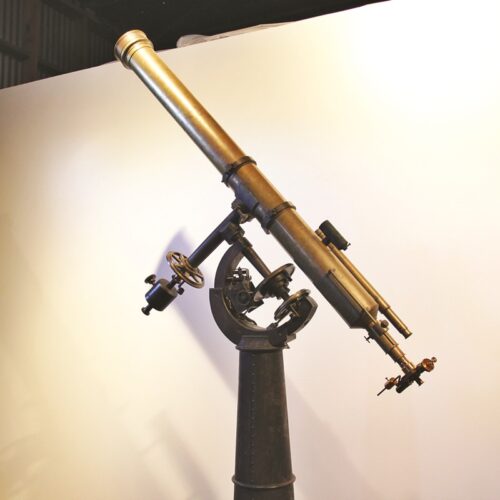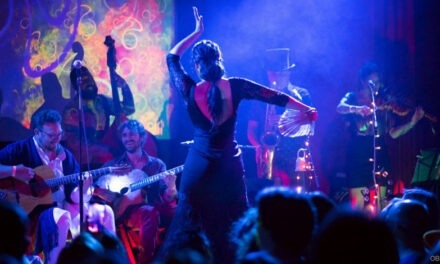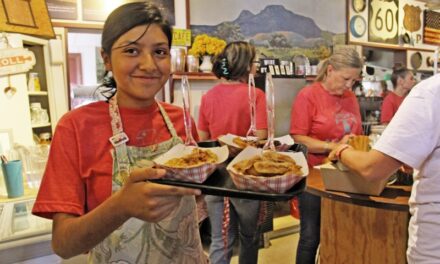
Magdalena artist Judy Richardson opened up her studio to visitors for Magdalena’s annual art event.
Cathy Cook | El Defensor Chieftain photos
ARTMagdalena was back and bustling in the Village of Magdalena over the weekend, with art galleries, studio tours and an exhibit that highlights the area’s star-gazing opportunities.
Over 100 people came through the Village Saturday morning to enjoy the annual art event. The show is an opportunity to feature local artists and galleries and bring visitors into Magdalena businesses.
Many visitors from all over the state visited the Dark Sky Land show at Warehouse 1-10, because they were part of astronomy clubs, said gallery owner Catherine DeMaria.
“They can see the history of astronomy, from looking at pieces that are from the 1700s to what we’re able to do with modern-day technology and modern-day lenses,” she said.
Some of the pieces bring surprising elements of artistry, like adding inverted black-and-white photography. There are also historical telescopes on display in the exhibit.
The nearby Astronomical Lyceum, run by John Briggs, has a large collection of historical objects related to astronomy.
“We have one of the most magnificent collections of historical telescopes, documentation, star maps, right here in the Village of Magdalena,” she said.
There are dozens of astronomers down the dark sky corridor from Magdalena Ridge Observatory all the way past Quemado. The Dark Sky Land exhibit will be open through June 17.
“Everybody’s already asking me to keep it up longer,” said DeMaria.
The gallery may try to add some more educational opportunities during the exhibit’s run.
The exhibit came about through a collaboration with documentary filmmaker Marisela La Grave, who is documenting the astronomical corridor and who advocates for dark skies. Preserving the dark skies near Magdalena is not that difficult, said DeMaria.
“It’s very little effort in order to preserve something that’s so unique to this region,” she said.
A few blocks away, Hills Snyder’s Kind of a Small Array gallery was open to visitors. The gallery celebrated five years in April. The intimate gallery space usually offers solo art shows and house concerts.
Snyder tries to support local New Mexico artists and tries to bring artists who otherwise wouldn’t be seen in Magdalena.

This historic telescope is one of many historical objects, art pieces and photographs on display at Warehouse 1-10.
The present exhibit is of collages and drawings by Estelle L. Roberge, who hikes in the Magdalena mountains and creates drawings and collages based on her experiences.
Roberge has been going up the mountain since 2002 and used to hike up as much as four times a week. She makes her hikes in all seasons, even in winter when the mountain is piled in snow.
“I have this great respect for the mountain and I’m very, very fond of my walking up there,” she said.
Her work in the exhibit was also by a book called “Mount Gloom and Mount Glory.”
“I was primarily a painter and a printmaker, mainly painting since 1997, and some printmaking from time to time. During Covid, I had a show at the New Mexico Cancer Center, and it was all painted. After that, we were into Covid, and after that, I just couldn’t paint anymore. It was like an impasse.”
To live during that isolated time, she decided to make collages to keep herself balanced.
“Every day, when I felt like I was going to go into a Covid panic, instead I would go into collage, and I became tranquil as a result of it. It was a way for me to keep my balance through the pandemic,” she said.
The collages are a kaleidoscope of textures, like that of the alligator juniper’s rough bark. Roberge produces much of the material for the collage’s herself, like photos and painting, although she also used handmade paper from Loretta Lowman.
The gallery’s owner Snyder is an artist himself, whose work takes form in varied mediums. One of his recent art shows was based around traveling to places with evocative names.
“I started in Nowhere, Oklahoma, then I went to Happy. I went to Recluse, I went to Diamondville, I went to Bummerville, I went to Nothing, I went to Eureka, Eden, Eldorado, Lost Nation, Waterloo, Funk, Downer.”
Then he created drawings in the towns and wrote a series about the travels.
“In a way, you’re kind of erasing yourself. You’re following a route that a tourist might follow, but you’re not really being a tourist.”
A neighbor to Snyder’s gallery is Judy Richardson’s art studio, a wide open space where she used to also live. Richardson draws, takes photographs, and constructs sculptural work using found objects. She moved from New York in 2019. While living there, she created work from found objects like furniture legs.
“I liked the fact that it was referential and that all those things had been things that people used,” she said.
But the New Mexico landscape has changed her sculptures.
“This place is not about that. It’s not about people here. We’re just like little visitors here. There are forces here, but we’re not them. There’s a lot of wind, there’s rocks, there’s plants that hold tightly to the ground.”
The toughness of the natural elements and the landscape’s history as a seafloor inspire her present work. She still collects found objects, but instead of metal scraps, she picks up discarded yucca hearts or the bark from dead cottonwoods.
“There’s a toughness about the things that grow here, so they can survive with the wind and very little water.”























